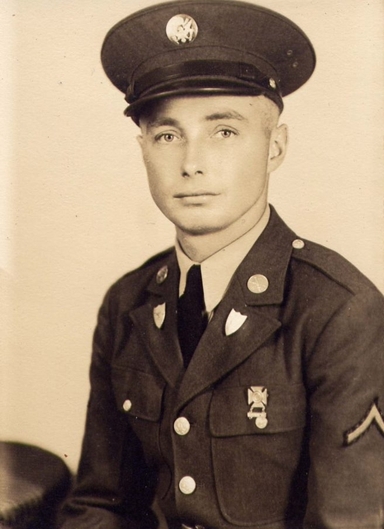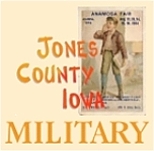Sgt. John C. F. Onken
September 5, 1912–June 6, 1944
Service #: 37039386
Residence: Jones, Iowa
Occupation: Farm hand
Marital Status: Single, no dependents
Enlistment Date: January, 1941
Enlistment Place: *****
Service/Unit: 4th Cavalry Reconnaissance, Troop A
Awards: Bronze Arrowhead
Burial: Peotone Cemetery, Peotone, Will, Illinois
Two Monticello Boys Killed "D" Day, June 6
Lieut. Richard N. Hoag, Sgt. John Onken Called
Lt. Richard N. Hoag and Sgt. John Onken both former residents of Monticello and vicinity, were killed in the invasion thrust in Normandy on D-day, June 6. Word of their untimely deaths was received, last Friday for Lt. Hoag, and Tuesday for Sgt. Onken. These were the first deaths to be reported on invasion day that affected this community.
The following obituaries of these young men tell of their active life in the service of the United States air corps and infantry.
Lt. Richard N. Hoag
Memorial services were held Monday evening at 8 o'clock at the Presbyterian church for the late Lt. Richard Nevin Hoag, who was killed D-day, June 6, in the invasion of France. The services were in charge of Dr. William J. Grossheim, pastor.
(See Lt. Richard N. Hoag.)
Sgt. John Onken
 Sgt. John C. F. Onken, a nephew of John Heyen of Langworthy and Mrs. J. C. Bolster of Scotch Grove, was killed in action in France on D-day, June 6. He was a member of the infantry and had entered the service in January, 1941. He had a furlough last summer and visited with his uncle and aunt before he went to England last winter.
Sgt. John C. F. Onken, a nephew of John Heyen of Langworthy and Mrs. J. C. Bolster of Scotch Grove, was killed in action in France on D-day, June 6. He was a member of the infantry and had entered the service in January, 1941. He had a furlough last summer and visited with his uncle and aunt before he went to England last winter.
Sgt. Onken wrote regularly to his uncle, and letters were received from him recently. He was unmarried and had returned to the United States from Germany with his brother, Edward, in 1927. Both of the boys had become naturalized and received their citizenship papers. Edward is in the United States army and when last heard from a year ago was serving in England.
Sgt. Onken was a son of the late Mr. and Mrs. John Onken and was born near Chicago Sept. 5, 1912. When he was two years old, the family returned to Germany, where the father was killed in the last week of World War I while serving with the German army. Later, the mother died.
Survivors of Sgt. Onken include his brother in the United States army in England; two sisters, Helen and Evalena in Germany; his uncle John Heyen, and aunt, Mrs. J. C. Bolster. The telegram from the War department announcing the death of Sgt. Onken was received by John Heyen July 4.
Source: Monticello Express, Monticello, Iowa, July 6, 1944
Submitted by: Sharon Oltmanns
Return of Body of John C. F. Onken
from British Military Cemetery.
Funeral services for Sgt. John C.F. Onken, brother of Edward H. Onken, now of Peotone, Ill, were held Sunday. July 25, at Peotone. Sgt. Onken and his brother will be remembered by many of this vicinity, having made their home with their great uncle, John Heyen, in Langworthy for many years. The information was given the Express by Edward, who has been visiting in the Heyen home the past week. Sgt. Onken was killed in action overseas on June 6, "D" Day. He was buried in France and later moved to the Brookwood Temporary Military Cemetery in the British Isles. He was born Sept. 1, 1912, in Peotone, the son of Mr. and John Onken, Sr. In 1914 he returned with his family to Germany to make their home. His father was killed in action in World War I and is buried in France. In May of 1929, John and Edward returned to this country and made their home in Langworthy. John entered the army on January 14, 1941 and served with the 4th Cavalry Reconnaissance Squadron at Forth Meade, S.D. He served overseas for 4 months before he was reported "missing in action" on "D" Day. Surviving in addition to his brother are two sisters living in Germany. His mother died on December 31, 1936 in Germany.
Source: Monticello Express, Monticello, Iowa, 8 Sept. 1948, page 1
4th Cavalry Reconnaissance, Troop A
By Shane E. Olson
Halma-Lake Bronson SAL Post Commander
MN USA
At 0530 (H minus 1 hours) on June 6th, 1944, prior to the main DDAY landings, Sgt. John C F Onken of Troop A was killed in action during the landing on Iles St Marcouf off the coast of Utah Beach. Awarded the Bronze Arrowhead posthumously. "Let us dedicate ourselves to the task of carrying on that those whom we honor shall not have died in vain."
Source: Behind the Badge
Submitted by: Sharon Oltmanns
Historical Information
During the planning for the landing on Utah Beach, the American high staff noticed the existence of two tiny islands off shore from the landing area, the Saint-Marcouf islands. What kind of threat could these islands represent? The bigger island, “île du Large,” had an old Napoleonic fort which indicated its strategic interest. The other island is the “île de Terre.”
What had the Germans, with all their tricks, set up there? Was it an observation post? A post controlling the naval minefields? The American staff was not going to ignore this risk.
The US 7th Corps had no unit of Rangers at its disposal, so it was decided to give the mission to the 4th Cavalry Group, a mechanized unit, specialized in reconnaissance operations.
Two teams of two men each would land as scouts on the beaches of the islands and then four LCA (a British model landing barge carrying thirty men) would follow with the main force to seize the islands.
The teams of scouts were composed of Sergeant (then Corporal) Harvey Olson and Private Thomas Killoran, both from the 4th Squadron, for the island “île de Terre” and Sergeant John Zanders and Corporal Melvin Kenzie, both from the 24th Squadron, for the island “île du Large.”
These scout teams approached the islands in rubber boats which they sunk offshore so they could swim silently to the beach. Armed only with knives, they brought flashlights to give the signal of approach to the two LCA for each island.
The first team to land was the one of Sergeant Olson and Private Killoran at about 0415 hrs. The 4th Cavalry Group seized the two islands. No German was found but the islands were full of S Mines, called by the GIs “bouncing betties”. These mines, once you have walked on them, bounce out of the ground to three feet high before exploding, propulsing steel balls and other splinters, reaching the men at half height. These mines caused 19 casualties, among them were two killed, Sergeant John Onken from the 4th Squadron and Private Anton Elvesaeter from the 24th Squadron (?).
The Napoleonic fort itself was rigged with explosives. The operation was over at 0530 hrs, one hour before the landing of the first seaborne troops (8th Infantry Regiment, 4th Infantry Division) on the coast of France.
Sergeant Olson received the Silver Star for his action on June 6 1944. He was wounded later during the fight at Villedieu and a second time at Mortain. But, he finished World War Two with his unit and participated in the war in Korea. He left the Army in 1963 and died in September 2002. His own father, Herbert Olson, had been seriously wounded at St Mihiel, France, during WWI.
Source: Liberation Museum—Sainte Marie du Mont (France)
Submitted by: Sharon Oltmanns







